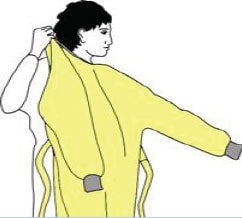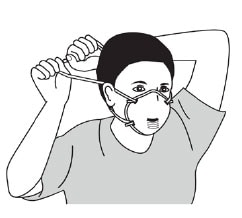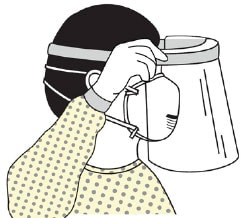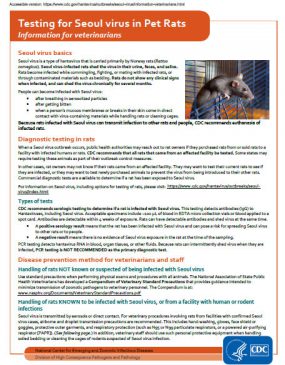Testing for Seoul Virus in Pet Rats: Information for Veterinarians
In December 2016, Seoul virus was found for the first time in the US in pet rats. Several people were infected after contact with infected rats. Some infected individuals were hospitalized and recovered. Concerned rat owners may ask veterinarians about Seoul virus, and this document provides information about:
- Seoul virus basics
- Diagnostic testing in rats
- Disease prevention methods
Seoul Virus Basics
Seoul virus is a type of hantavirus that is carried primarily by Norway rats (Rattus norvegicus). Seoul virus-infected rats shed the virus in their urine, feces, and saliva. Rats become infected while commingling, fighting, or mating with infected rats, or through contaminated materials such as bedding. Rats do not show any clinical signs when infected, and can shed the virus chronically for several months. People can become infected with Seoul virus after breathing in aerosolized particles, getting bitten, or when a person’s mucous membranes or breaks in their skin come in direct contact with virus-containing materials while handling rats or cleaning cages. Because rats infected with Seoul virus can transmit infection to other rats and people, CDC recommends euthanasia of infected rats.
Diagnostic Testing in Rats
When a Seoul virus outbreak occurs, public health authorities may reach out to rat owners if they purchased rats from or sold rats to a facility with infected humans or rats. CDC recommends that all rats that came from an affected facility be tested. Some states may require testing these animals as part of their outbreak control measures.
In other cases, rat owners may not know if their rats came from an affected facility. They may want to test their current rats to see if they are infected, or they may want to test newly purchased animals to prevent the virus from being introduced to their other rats. Commercial diagnostic tests are available to determine if a rat has been exposed to Seoul virus. For more information on Seoul virus, including options for testing.
Types of Tests
CDC recommends serologic testing to determine if a rat is infected with Seoul virus. This testing detects antibodies (IgG) to Hantaviruses, including Seoul virus. Acceptable specimens include ~100 uL of blood in EDTA micro vials or blood applied to a spot card.
A positive serology result means that the rat has been infected with Seoul virus and can pose a risk for spreading Seoul virus to other rats or to people. A negative result means there is no evidence of Seoul virus exposure in the rat at the time of the sampling. Antibodies are detectable within 4 weeks of exposure. Rats can have detectable antibodies and shed virus at the same time.
PCR testing detects Hantavirus RNA in blood, organ tissues, or other fluids. Because rats can intermittently shed virus when they are infected, PCR testing is NOT RECOMMENDED as the primary diagnostic test.
Disease Prevention Methods for Veterinarians and Veterinary Staff
Handling of rats NOT known or suspected of being infected with Seoul virus:
Use standard precautions when performing physical exams and procedures with all animals. The National Association of State Public Health Veterinarians has developed a Compendium of Veterinary Standard Precautions that provides guidance intended to minimize transmission of zoonotic pathogens to veterinary personnel. Review the 2015 Compendium Cdc-pdf
Handling of rats KNOWN to be infected with Seoul virus, or from a facility with human or rodent infections:
Seoul virus is transmitted by aerosols or direct contact. For veterinary procedures involving rats from facilities with confirmed Seoul virus cases, airborne and droplet transmission precautions are recommended. This includes hand-washing, gloves, face shield or goggles, protective outer garments, and respiratory protection (such as N95 or N99 particulate respirators, or a powered air-purifying respirator [PAPR]**). See Personal Protective Equipment for Veterinarians and Veterinary Staff. In addition, veterinary staff should use such personal protective equipment when handling soiled bedding or cleaning the cages of rodents suspected of Seoul virus infection.
- Ensure staff understand how to handle rodents, including during any planned procedures (such as blood draws or euthanasia). Provide training in advance.
- Schedule this appointment as the last appointment of the day, or at a time when the clinic is less busy.
- Request that the client bring rat(s) in a bare cage or carrier with no bedding. Suggest that the client drape a towel across the outside of the cage during transit. If possible, admit the client through a side entrance, rather than through the main lobby.
- When the client arrives, bring them directly into an exam room.
If the work surface or personnel’s gloves or clothing became contaminated with rodent excreta or blood during the handling procedures, a spray bottle of disinfectant should be available and used to spray the contaminated area. After disinfection, clothing may be laundered normally.
After the visit, wipe down all surfaces, including the cage/carrier that the rat was transported in, with an appropriate disinfectant. Allow to air dry.
Personal Protective Equipment for Veterinarians and Veterinary Staff
Any staff who will be directly handling a rat known to be infected with Seoul virus or performing veterinary procedures on it should follow droplet and aerosol transmission guidance, including:
- Fluid-impermeable disposable surgical gown
- Two pairs of non-powdered nitrile medical-grade gloves plus a thick protective glove. Protective gloves may be made of leather or of fabric with a rubber outer coating that is resistant to puncture from rodent bites or scratches and is easy to disinfect.
- A NIOSH-certified N95 filtering facepiece respirator or higher or a powered air purifying respirator (PAPR) equipped with a high-efficiency particulate air filter (HEPA).
Note: Respirator use should be in the context of a complete respiratory protection program in accordance with the Occupational Safety and Health Administration (OSHA) Respiratory Protection standard (29 CFR 1910.134) and other requirements. Staff who will need to wear N95 (or higher) respirators should be medically cleared, trained, and fit-tested for respirator use. Detailed information on respiratory protection programs, including fit testing procedures, can be accessed at OSHA’s Respiratory Protection eToolExternal
- Tight-fitting respirators cannot be used by people with facial hair that comes between the sealing surface of the facepiece and the face; loose-fitting powered air purifying respirators (PAPRs) can be worn by those with facial hair.
- If a filtering facepiece respirator is worn, also wear a disposable full face shield or goggles to protect mucous membranes from any accidental splashes of rodent urine or blood.

Fluid impermeable disposable surgical gown

Two pairs of non-powdered nitrile medical-grade gloves plus a thick protective glove

A NIOSH-certified N95 filtering facepiece respirator or higher or a powered air purifying respirator (PAPR) equipped with a high-efficiency particulate air filter (HEPA).

A disposable full face shield or goggles
Remove personal protective equipment Cdc-pdf
- Remove outside pair of gloves, face shield, and protective gown.
- Wash hands with soap and water (with second pair of gloves still on).
- Remove second pair of gloves.
- Wash your hands with soap and water again.
Reporting of Illness
Veterinary staff and rat owners should receive information about the signs and symptoms of Seoul virus infection. Employers should document which employees handle potential infected animals and the date(s) of potential exposure. If anyone who handled infected rats develops sudden flu-like symptoms occur within 8 weeks after exposure to a new rodent or after a bite, scratch, or breach of PPE, they should seek health care promptly and inform their employer and local health department, making them aware of any recent animal contact.
Handling Euthanasia Requests
If an owner requests euthanasia, follow AVMA-approved methods Cdc-pdf
After euthanasia:
- Spray carcass with a disinfectant or a mixture of bleach and water.
- Place carcass in a biohazard bag for infectious waste. Gently close the bag at the top and seal shut with tape. Avoid squeezing or pressing the bag to get excess air out. Spray outside of this bag with disinfectant or bleach solution.
- Place the taped, sprayed, biohazard bag into a second empty biohazard bag. Gently close this bag at the top and seal shut with tape. Avoid squeezing or pressing the bag to get excess air out. Spray outside of this bag with disinfectant or bleach solution.
- Rat carcasses may be incinerated, buried, or disposed of using routine procedures for carcass handling at the veterinary hospital, ensuring workers do not open the bags before disposal.
Disinfectants
- Hantaviruses like Seoul virus are sensitive to dilute hypochlorite solutions (10% household bleach), Lysol and other phenolics, detergents, and most general-purpose household disinfectants.
- A 1% (1:100 dilution) solution of household bleach is an adequate surface disinfectant which can be used for wiping down potentially contaminated surfaces. For heavily soiled areas or items contaminated with rodent feces or nesting items, a 10% solution is recommended.
- An appropriate disinfectant should always be used:
- To decontaminate traps which contained or were soiled by rodents
- To clean rubber gloves after handling traps which contain rodents or that have been soiled by rodents
- To clean gloved hands after each rodent is handled and before removing gloves
- To soak and disinfect instruments and other equipment
- To clean working surfaces and other items that may have been contaminated by handling rodents
For more information on Seoul virus, including options for testing of rats.
